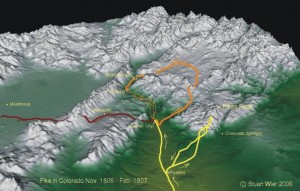Brief by Central Staff
Transportation – March 2007 – Colorado Central Magazine
It’s been a long time — perhaps the standard-gauging of the Monarch Quarry line in 1956 — since there’s been any railroad construction in this part of the world.
But Permian Basin Railways is looking into some construction. It has hired an engineering firm to examine the possibility of building a 17-mile branch line from South Fork to the summit of Wolf Creek Pass.
Permian owns the San Luis & Rio Grande Railroad, which was formed out of part of the old Denver & Rio Grande Western system. The SL&RG has about 150 miles of track, extending from Walsenburg west over Veta Pass to Alamosa, with branches from there south to Antonito and west to South Fork (actually, a siding called Derrick, just west of South Fork).
The trackage from Derrick to Creede is not owned by SL&RG; it belongs to the Denver & Rio Grande Historical Foundation. And near Monte Vista, the SL&RG connects with the San Luis Central, which runs north to Center.
Ed Ellis, president of the SL&RG, told the Pueblo Chieftain that the Wolf Creek line has nothing to do with the proposed base-area development at the Wolf Creek Ski Area — something opposed by the ski area’s owners.
He also observed that the line would be “very expensive. It’s a difficult terrain,” with construction costs estimated at $100 million to $1 billion.
But apparently it’s worth looking into, regardless.
That’s about all we know regarding this, but it’s interesting to speculate. SL&RG runs summer passenger excursions over the pass between Alamosa and La Veta, so it has an investment in passenger equipment that sits idle in the winter.
Suppose, then, that one could board a train in Alamosa (or Monte Vista, Del Norte, or South Fork) to go skiing for the day at Wolf Creek, and could then return in comfort without the hassle of driving on that winding snowy road.
Those towns — all of which would presumably enjoy more business — could provide the lodging, restaurant, and entertainment associated with ski vacations. There wouldn’t be any need for that controversial development atop Wolf Creek Pass.
From what we could find after delving into railroad lore, the Denver & Rio Grande gave little consideration to Wolf Creek Pass when it built its “San Juan Extension” from Alamosa to Durango in 1880-81. Instead, the line took a more southerly route over Cumbres Pass. Cumbres was the high point, but it was not a Continental Divide crossing, since both sides drain into the Rio Grande. The actual divide crossing was a few miles west of Chama, N.M., at Azotea, elevation 7,733.
The Cumbres route was longer, but at 10,022 feet it was lower than Wolf Creek’s 10,850, and that meant easier grades for the locomotives. The Rio Grande’s locating engineers, if given a choice between a short steep grade and a long curving route with a gentle grade, generally took the long way. Compare the twisting Rio Grande route up the east side of Marshall Pass to the relatively straight Union Pacific route up Chalk Creek to the Alpine Tunnel — both built at about the same time to reach the same destination, Gunnison.
Further, Cumbres does get snow, 264 inches in an average year, but that’s considerably less than Wolf Creek’s 352 inches. The less snow, the less expense for plowing.
Of course, all that snow is the reason there’s a ski area atop Wolf Creek that might justify rail service.

